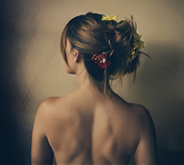This post is Part 3 of Photography Questions and Answers for Beginners. You can check our previous posts here:
- Photography Basics – Questions and Answers for Beginners – Part 1
- Photography Basics – Questions and Answers for Beginners – Part 2
What is Symmetry Composition in Photography?

Photo Credit : Philipp Klinger
A striking, but easily balanced composition is a symmetrical one. Symmetrical photographs are those which have near identical elements on either side of an imaginary vertical or horizontal line and, as a consequence, have eye-catching appeal. As a starting point, place the main elements of your composition in the centre of the frame until a balance is achieved along the vertical or horizontal axis. Architectural and landscape subjects work well with this kind of approach, but you may need to pull in additional items in the frame to balance things out. These kinds of images don’t need to be mathematically equal; the results can look very artificial they are.
What is Digital Image Sensor?

Photo Credit : SensorCleaning.com
When the reflective light from the photographed subject passes through the lens and aperture, the image is captured by the digital image sensor. A digital image sensor is the computer chip inside the camera that consists of millions of individual elements capable of capturing light. The light-sensitive elements transform light energy to voltage values based on the intensity of the light. The voltage values are then converted to digital data by an analog-to-digital converter (ADC) chip. This process is referred to as analog-to digital conversion. The digital numbers corresponding to the voltage values for each element combine to create the tonal and color values of the image.
Each light-sensitive element on a digital image sensor is fitted with either a red, green, or blue filter, corresponding to a color channel in a pixel in the image that is captured. There are roughly twice as many green filters as blue and red to accommodate how the eye perceives color. This color arrangement is also known as the Bayer pattern color filter array. There are basically two types of Digital Image Sensors typically used: a Charge-Coupled Device (CCD) and a Complementary Metal Oxide Semi-Conductor (CMOS).
How Inkjet Printer Works?

Like the grain in photographic film, an Inkjet Printer uses tiny dots to create the illusion of color by mixing at least four ink colors: Cyan, Magenta, Yellow and Black (CMYK). The resulting color print is constructed out of million of tiny drops of color, set at different distances from each other and when viewed from a distance, they merged to create the impression of photographic color.
Super High-Resolution Printers can spray 2880 and more droplets of different sizes on a square inch of printing paper to produce a photorealistic effect.
What is Over Exposure?

Photo Credit : Beth Retro
An overexposed photograph is one that is considered too light or too bright. On a technical level, overexposure happens because the amount of light hitting the sensor is simply too much for the sensor to handle. In digital photography, this usually means that the bright sections of the image, the highlights, become pure white with no detail at all. Sometimes, an overexposed image is simply one that looks pale or washed out.
Highlights that are all totally white are called blown-out highlights and can be found in images of bright skies, reflections off of shiny objects, or when part of the image is in deep shadow and part of the image is in bright light. In histogram terms, overexposure is also described as clipped whites.
What is Under Exposure?

Photo Credit : Richard Reader
Underexposed photographs are considered to be too dark and murky. One of the biggest issues with underexposure is simply the lack of detail in the shadows in the photograph. Another large problem with underexposed photos is the increased noise in the dark areas of the photograph. If a reasonably well-lit image is simply underexposed, it will be too dark, the areas in the photograph with shadows and very dark tones will become black, and those shadow tones will look blocked up, having little to no detail.
Underexposure can be beneficial at times. If an image is only slightly underexposed, it also might make the image a little richer at the cost of losing only a little bit of the shadow detail. When a photograph looks washed out, especially a landscape, underexposing the scene from the meter’s recommendation by 1/3 to 2/3 of an f-stop can be just the ticket to make the photo more dramatic and lively.
When you look at a histogram of an underexposed photograph, most of the pixel bars will be grouped to the left side of the graph, meaning that a bulk of the pixels in the image are dark, shadows, or even black. When an image is underexposed and is not supposed to be, trying to lighten the image in the computer usually creates a lot of noise in the image. So while there still may be detail in those dark shadows, bringing the details out needs to be done judiciously.
Underexposed photographs often have histograms with what is referred to as clipped blacks. Having clipped black tones means that the pixel bars of the histogram are not only on the left side of the graph but also all bunched up against the top edge of the graph.
Like the article? Be sure to subscribe to our RSS feed, follow us on Twitter and Facebook to stay up on recent content.











